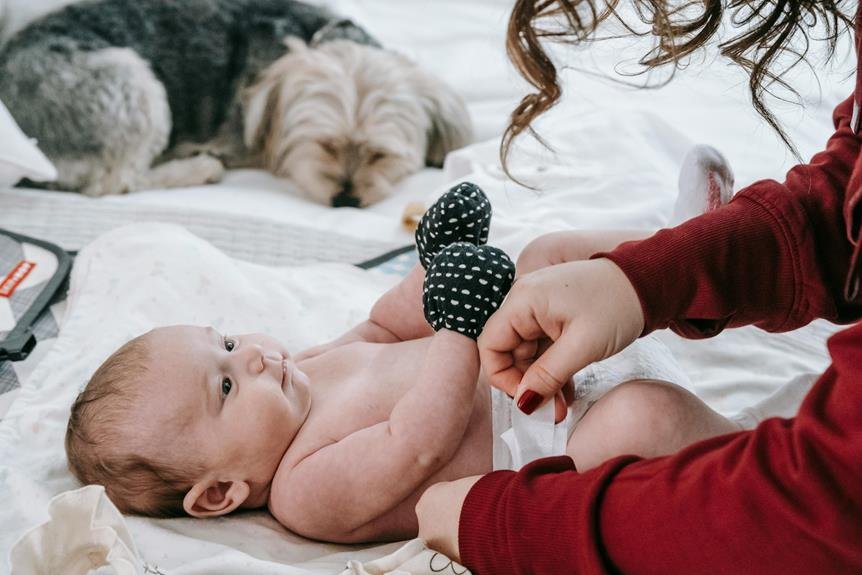When it comes to changing your baby's diaper, the frequency is crucial for their well-being. You may wonder about the ideal intervals for diaper changes as your little one grows. The key lies in maintaining a balance between keeping them dry and preventing any skin irritations. By understanding the cues your baby gives and adapting to their needs, you can ensure comfort and good hygiene. But what factors should you consider beyond just the time intervals? Stay tuned to discover the nuances of diaper changing that can make a significant difference in your baby's daily routine.
Newborns
If you're wondering how often to change your newborn's diaper, experts recommend changing it every 2 to 3 hours. Newborns have very sensitive skin and frequent diaper changes are essential to prevent diaper rash and keep them comfortable. Remember to change their diaper before or after every feeding, as this is a good way to ensure you're keeping up with the recommended frequency.
Newborns tend to have around 8 to 12 diaper changes per day, so it's a good idea to establish a routine early on. Make sure to clean the diaper area thoroughly during each change and apply a thin layer of diaper cream to protect their delicate skin. Additionally, be mindful of signs that your baby's diaper needs changing, such as fussiness or a soiled diaper indicator.
Infants
For infants, ensure you change their diaper every 3 to 4 hours to maintain their comfort and skin health. Babies at this stage are more active and may produce more urine and stool compared to newborns. Keeping a regular diaper-changing schedule helps prevent diaper rash and keeps your baby feeling fresh.
During the day, changing your infant's diaper every 3 to 4 hours is generally sufficient. However, it's essential to be attentive to their cues. If your baby shows signs of discomfort or their diaper feels full, don't hesitate to change it promptly.
Remember to clean your baby's diaper area thoroughly during each change to reduce the risk of irritation. Use mild wipes or warm water and gentle baby soap to cleanse the skin before putting on a fresh diaper. Additionally, allowing your baby some diaper-free time each day can help their skin breathe and reduce the likelihood of developing diaper rash. By following these simple steps, you can help keep your infant happy, healthy, and comfortable.
Toddlers
To maintain your toddler's comfort and hygiene, ensure you change their diaper every 4 to 5 hours as they become more active and their bladder capacity increases. Toddlers are often on the move, exploring their surroundings, and engaging in various activities that can lead to increased wetness and potential diaper leaks. Changing their diaper regularly helps prevent rashes, discomfort, and irritations that can occur when the diaper is left on for too long.
Additionally, toddlers may start showing signs of readiness for potty training, such as staying dry for longer periods or expressing interest in using the toilet. Encouraging these behaviors and offering opportunities for them to use the potty can help transition your toddler out of diapers.
It's essential to check your toddler's diaper frequently for wetness or soiling, especially after meals or when they wake up from naps. Keeping a routine and being consistent with diaper changes can contribute to your toddler's overall comfort and well-being.
Overnight
Ensure your baby's overnight comfort and dryness by changing their diaper right before they go to sleep. Overnight diaper changes are crucial to prevent leaks and discomfort during the night. Use a high-absorbency diaper to minimize the chances of leakage while your baby sleeps. Opt for a diaper specifically designed for overnight use, as these are often more absorbent and can provide extra protection for longer periods.
It is recommended to check your baby's diaper during the night, especially if they tend to sleep for extended periods. If the diaper feels full or if your baby wakes up, consider changing it to ensure their comfort and prevent any potential skin irritation. Additionally, applying a diaper rash cream before putting on a fresh diaper can help protect your baby's delicate skin throughout the night.
Remember that each baby is different, so you may need to experiment with different diaper brands or sizes to find the one that best suits your baby's needs for overnight dryness and comfort.

